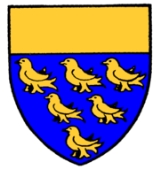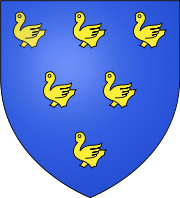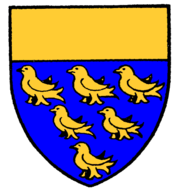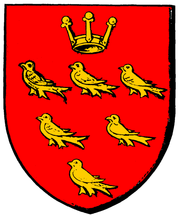
Coat of arms of Sussex
Encyclopedia
A coat of arms
has been associated with the historic county
of Sussex
since the seventeenth century. The device, displaying six martlet
s or heraldic swallows on a shield, later formed the basis of the flag of Sussex
and the armorial bearings granted to the county council
s of East
and West Sussex
.
 The earliest recorded use of the arms appears to be in the atlas
The earliest recorded use of the arms appears to be in the atlas
Theatrum Imperii Maganae Britanniae produced by John Speed
in 1622. The book displays arms for each of the seven kingdoms of the Anglo-Saxon
heptarchy
, and that shown for the Kingdom of the South Saxons
was six golden martlets on both a blue (azure) or red (gules) shield. In both cases the arms were ensigned by an ancient crown. It is possible that the device had a much earlier origin, as arms were attributed to other Saxon kingdoms by the herald
s in the later Middle Ages
. These attributed arms were a prochronism
, as heraldry
did not develop until some centuries after the existence of the kingdoms. The arms later used by local authorities in Essex
, Middlesex
, Kent
, Northumberland
and County Durham
all owe their origins to the medieval heralds.
introduced administrative counties
each governed by an elected county council. Sussex was divided into two administrative counties: East and West Sussex. Each county council was required to adopt a common seal.
 West Sussex County Council promptly applied to the College of Arms
West Sussex County Council promptly applied to the College of Arms
for a grant of arms, which were granted on May 18, 1889. The cost of the grant was met by the Duke of Norfolk
, a member of the council and titular head of the College of Arms. West Sussex was the first county council to become armigerous.
The arms were the same as those associated with the historic county with the addition of a gold "chief" or band at the top of the shield. The blazon
or technical description was:
Azure, six martlets, three, two and one a chief or.
 East Sussex County Council adopted a seal in 1889. The seal bore a quartered shield.
East Sussex County Council adopted a seal in 1889. The seal bore a quartered shield.
These unofficial arms remained in use until 1937 when an a grant of arms from the College of Arms was obtained on September 10. A red shield was adopted and a gold Saxon crown was added for heraldic difference. The arms were blazoned as:
Gules, six martlets three, two and one, and in chief a Saxon crown or
reorganised councils throughout England
and Wales
from 1974. In Sussex two new non-metropolitan counties of East Sussex and West Sussex were created, but with different boundaries to the administrative counties abolished by the 1972 Act. Accordingly the two county councils had to apply for new arms. Both county councils were granted arms in 1975, based on those previously used.
West Sussex County Council was granted arms on January 14, 1975. The gold chief of the 1889 shield was modified by being given an "indented" edge. A crest was added, shown atop a helm and decorative mantling. The crest represented the areas transferred from East Sussex and Surrey
in 1974: the Saxon crown was taken from the East Sussex arms and the acorns from those of Surrey.
The blazon of the arms is:
Azure six martlets three two and one and a chief indented or, and for a crest on a wreath of the colours a sprig of oak proper fructed with two acorns or within a Saxon crown also or.
 East Sussex County Council was granted a new coat of arms on August 29, 1975. The arms are identical to the 1937 grant with the addition of a silver wavy line, representative of the coastal county borough
East Sussex County Council was granted a new coat of arms on August 29, 1975. The arms are identical to the 1937 grant with the addition of a silver wavy line, representative of the coastal county borough
s of Brighton
, Eastbourne
and Hastings
added to the county in 1974.
Authority was granted arms on May 30, 1969: a blue shield bearing a gold tower between five gold martlets. The Sussex County Cricket Club
uses the traditional county arms as its badge.
Coat of arms
A coat of arms is a unique heraldic design on a shield or escutcheon or on a surcoat or tabard used to cover and protect armour and to identify the wearer. Thus the term is often stated as "coat-armour", because it was anciently displayed on the front of a coat of cloth...
has been associated with the historic county
Historic counties of England
The historic counties of England are subdivisions of England established for administration by the Normans and in most cases based on earlier Anglo-Saxon kingdoms and shires...
of Sussex
Sussex
Sussex , from the Old English Sūþsēaxe , is an historic county in South East England corresponding roughly in area to the ancient Kingdom of Sussex. It is bounded on the north by Surrey, east by Kent, south by the English Channel, and west by Hampshire, and is divided for local government into West...
since the seventeenth century. The device, displaying six martlet
Martlet
A martlet is a heraldic charge depicting a stylized bird with short tufts of feathers in the place of legs...
s or heraldic swallows on a shield, later formed the basis of the flag of Sussex
Flag of Sussex
The Flag of Sussex is the flag of the English county of Sussex. The flag was registered by the Flag Institute on Friday 20 May 2011 as a 'traditional' county flag and was certified by Chief Vexillologist, Graham Bartram...
and the armorial bearings granted to the county council
County council
A county council is the elected administrative body governing an area known as a county. This term has slightly different meanings in different countries.-United Kingdom:...
s of East
East Sussex
East Sussex is a county in South East England. It is bordered by the counties of Kent, Surrey and West Sussex, and to the south by the English Channel.-History:...
and West Sussex
West Sussex
West Sussex is a county in the south of England, bordering onto East Sussex , Hampshire and Surrey. The county of Sussex has been divided into East and West since the 12th century, and obtained separate county councils in 1888, but it remained a single ceremonial county until 1974 and the coming...
.
Origins of the arms

Atlas
An atlas is a collection of maps; it is typically a map of Earth or a region of Earth, but there are atlases of the other planets in the Solar System. Atlases have traditionally been bound into book form, but today many atlases are in multimedia formats...
Theatrum Imperii Maganae Britanniae produced by John Speed
John Speed
John Speed was an English historian and cartographer.-Life:He was born at Farndon, Cheshire, and went into his father's tailoring business where he worked until he was about 50...
in 1622. The book displays arms for each of the seven kingdoms of the Anglo-Saxon
Anglo-Saxons
Anglo-Saxon is a term used by historians to designate the Germanic tribes who invaded and settled the south and east of Great Britain beginning in the early 5th century AD, and the period from their creation of the English nation to the Norman conquest. The Anglo-Saxon Era denotes the period of...
heptarchy
Heptarchy
The Heptarchy is a collective name applied to the Anglo-Saxon kingdoms of south, east, and central Great Britain during late antiquity and the early Middle Ages, conventionally identified as seven: Northumbria, Mercia, East Anglia, Essex, Kent, Sussex and Wessex...
, and that shown for the Kingdom of the South Saxons
Kingdom of Sussex
The Kingdom of Sussex or Kingdom of the South Saxons was a Saxon colony and later independent kingdom of the Saxons, on the south coast of England. Its boundaries coincided in general with those of the earlier kingdom of the Regnenses and the later county of Sussex. A large part of its territory...
was six golden martlets on both a blue (azure) or red (gules) shield. In both cases the arms were ensigned by an ancient crown. It is possible that the device had a much earlier origin, as arms were attributed to other Saxon kingdoms by the herald
Herald
A herald, or, more correctly, a herald of arms, is an officer of arms, ranking between pursuivant and king of arms. The title is often applied erroneously to all officers of arms....
s in the later Middle Ages
Middle Ages
The Middle Ages is a periodization of European history from the 5th century to the 15th century. The Middle Ages follows the fall of the Western Roman Empire in 476 and precedes the Early Modern Era. It is the middle period of a three-period division of Western history: Classic, Medieval and Modern...
. These attributed arms were a prochronism
Anachronism
An anachronism—from the Greek ανά and χρόνος — is an inconsistency in some chronological arrangement, especially a chronological misplacing of persons, events, objects, or customs in regard to each other...
, as heraldry
Heraldry
Heraldry is the profession, study, or art of creating, granting, and blazoning arms and ruling on questions of rank or protocol, as exercised by an officer of arms. Heraldry comes from Anglo-Norman herald, from the Germanic compound harja-waldaz, "army commander"...
did not develop until some centuries after the existence of the kingdoms. The arms later used by local authorities in Essex
Essex
Essex is a ceremonial and non-metropolitan county in the East region of England, and one of the home counties. It is located to the northeast of Greater London. It borders with Cambridgeshire and Suffolk to the north, Hertfordshire to the west, Kent to the South and London to the south west...
, Middlesex
Middlesex
Middlesex is one of the historic counties of England and the second smallest by area. The low-lying county contained the wealthy and politically independent City of London on its southern boundary and was dominated by it from a very early time...
, Kent
Kent
Kent is a county in southeast England, and is one of the home counties. It borders East Sussex, Surrey and Greater London and has a defined boundary with Essex in the middle of the Thames Estuary. The ceremonial county boundaries of Kent include the shire county of Kent and the unitary borough of...
, Northumberland
Northumberland
Northumberland is the northernmost ceremonial county and a unitary district in North East England. For Eurostat purposes Northumberland is a NUTS 3 region and is one of three boroughs or unitary districts that comprise the "Northumberland and Tyne and Wear" NUTS 2 region...
and County Durham
County Durham
County Durham is a ceremonial county and unitary district in north east England. The county town is Durham. The largest settlement in the ceremonial county is the town of Darlington...
all owe their origins to the medieval heralds.
Adoption by county authorities
By the nineteenth century the blue shield bearing gold martlets had become accepted as an emblem of the county of Sussex. The seal of the clerk of the peace of the county bore the arms, as did the badges of the East Sussex Constabulary and the Sussex Yeomanry.1889 - 1974
The Local Government Act 1888Local Government Act 1888
The Local Government Act 1888 was an Act of the Parliament of the United Kingdom, which established county councils and county borough councils in England and Wales...
introduced administrative counties
Administrative county
An administrative county was an administrative division in England and Wales and Ireland used for the purposes of local government. They are now abolished, although in Northern Ireland their former areas are used as the basis for lieutenancy....
each governed by an elected county council. Sussex was divided into two administrative counties: East and West Sussex. Each county council was required to adopt a common seal.

College of Arms
The College of Arms, or Heralds’ College, is an office regulating heraldry and granting new armorial bearings for England, Wales and Northern Ireland...
for a grant of arms, which were granted on May 18, 1889. The cost of the grant was met by the Duke of Norfolk
Henry Fitzalan-Howard, 15th Duke of Norfolk
Henry Fitzalan-Howard, 15th Duke of Norfolk, , styled Baron Maltravers until 1856 and Earl of Arundel and Surrey between 1856 and 1860, was a British Unionist politician and philanthropist...
, a member of the council and titular head of the College of Arms. West Sussex was the first county council to become armigerous.
The arms were the same as those associated with the historic county with the addition of a gold "chief" or band at the top of the shield. The blazon
Blazon
In heraldry and heraldic vexillology, a blazon is a formal description of a coat of arms, flag or similar emblem, from which the reader can reconstruct the appropriate image...
or technical description was:
Azure, six martlets, three, two and one a chief or.

- The first quarter bore the traditional six gold martlets on blue of Sussex,
- The second quarter consisted of gold and blue checks from tha arms of the De Warenne family, Earls of Surrey and lords of the barony of LewesLewesLewes is the county town of East Sussex, England and historically of all of Sussex. It is a civil parish and is the centre of the Lewes local government district. The settlement has a history as a bridging point and as a market town, and today as a communications hub and tourist-oriented town...
. - The third quarter was gold with a red displayed eagle, arms of the De Aquila family, lords of PevenseyPevenseyPevensey is a village and civil parish in the Wealden district of East Sussex, England. The main village is located 5 miles north-east of Eastbourne, one mile inland from Pevensey Bay. The settlement of Pevensey Bay forms part of the parish.-Geography:The village of Pevensey is located on...
- The fourth quarter bore the arms of the Cinque PortsCinque PortsThe Confederation of Cinque Ports is a historic series of coastal towns in Kent and Sussex. It was originally formed for military and trade purposes, but is now entirely ceremonial. It lies at the eastern end of the English Channel, where the crossing to the continent is narrowest...
.
These unofficial arms remained in use until 1937 when an a grant of arms from the College of Arms was obtained on September 10. A red shield was adopted and a gold Saxon crown was added for heraldic difference. The arms were blazoned as:
Gules, six martlets three, two and one, and in chief a Saxon crown or
Since 1974
The Local Government Act 1972Local Government Act 1972
The Local Government Act 1972 is an Act of Parliament in the United Kingdom that reformed local government in England and Wales on 1 April 1974....
reorganised councils throughout England
England
England is a country that is part of the United Kingdom. It shares land borders with Scotland to the north and Wales to the west; the Irish Sea is to the north west, the Celtic Sea to the south west, with the North Sea to the east and the English Channel to the south separating it from continental...
and Wales
Wales
Wales is a country that is part of the United Kingdom and the island of Great Britain, bordered by England to its east and the Atlantic Ocean and Irish Sea to its west. It has a population of three million, and a total area of 20,779 km²...
from 1974. In Sussex two new non-metropolitan counties of East Sussex and West Sussex were created, but with different boundaries to the administrative counties abolished by the 1972 Act. Accordingly the two county councils had to apply for new arms. Both county councils were granted arms in 1975, based on those previously used.
West Sussex County Council was granted arms on January 14, 1975. The gold chief of the 1889 shield was modified by being given an "indented" edge. A crest was added, shown atop a helm and decorative mantling. The crest represented the areas transferred from East Sussex and Surrey
Surrey
Surrey is a county in the South East of England and is one of the Home Counties. The county borders Greater London, Kent, East Sussex, West Sussex, Hampshire and Berkshire. The historic county town is Guildford. Surrey County Council sits at Kingston upon Thames, although this has been part of...
in 1974: the Saxon crown was taken from the East Sussex arms and the acorns from those of Surrey.
The blazon of the arms is:
Azure six martlets three two and one and a chief indented or, and for a crest on a wreath of the colours a sprig of oak proper fructed with two acorns or within a Saxon crown also or.

County borough
County borough is a term introduced in 1889 in the United Kingdom of Great Britain and Ireland , to refer to a borough or a city independent of county council control. They were abolished by the Local Government Act 1972 in England and Wales, but continue in use for lieutenancy and shrievalty in...
s of Brighton
Brighton
Brighton is the major part of the city of Brighton and Hove in East Sussex, England on the south coast of Great Britain...
, Eastbourne
Eastbourne
Eastbourne is a large town and borough in East Sussex, on the south coast of England between Brighton and Hastings. The town is situated at the eastern end of the chalk South Downs alongside the high cliff at Beachy Head...
and Hastings
Hastings
Hastings is a town and borough in the county of East Sussex on the south coast of England. The town is located east of the county town of Lewes and south east of London, and has an estimated population of 86,900....
added to the county in 1974.
Other Sussex organisations
The Sussex PoliceSussex Police
Sussex Police is the territorial police force responsible for policing East Sussex, West Sussex and City of Brighton and Hove in southern England. Its head office is in Lewes, Lewes District, East Sussex.-History:...
Authority was granted arms on May 30, 1969: a blue shield bearing a gold tower between five gold martlets. The Sussex County Cricket Club
Sussex County Cricket Club
Sussex County Cricket Club is the oldest of the 18 major county clubs which make up the English and Welsh domestic cricket structure, representing the historic county of Sussex. The club was founded as a successor to Brighton Cricket Club which was a representative of the county of Sussex as a...
uses the traditional county arms as its badge.

